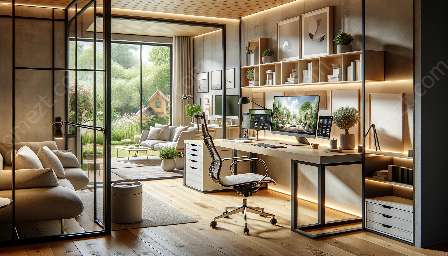Setting up your home office with the right lighting design is crucial for creating a comfortable and productive workspace. The right lighting not only enhances the aesthetic appeal of your office but also plays a vital role in boosting your overall well-being and productivity. In this comprehensive guide, we'll explore different aspects of home office lighting design, covering everything from the best lighting fixtures to the role of technology and intelligent home design in creating the perfect lighting environment.
Understanding the Importance of Home Office Lighting
Proper lighting is essential in maintaining your focus and reducing eye strain as you work in your home office. Insufficient or improper lighting can lead to headaches, eyestrain, and overall discomfort, which can significantly impact your productivity and well-being.
Moreover, a well-lit office space can help create an inviting and inspiring atmosphere, making you feel more motivated and engaged in your work. It can also contribute to the overall aesthetic appeal of your home office, complementing the design elements and technology you've incorporated.
Factors to Consider in Home Office Lighting Design
1. Natural Lighting
Utilizing natural light is a cost-effective and energy-efficient way to light your home office. Position your workspace near windows to make the most of natural daylight. Consider using sheer curtains or blinds that can diffuse the light and reduce glare.
2. Artificial Lighting
Supplementing natural light with artificial lighting is essential, especially during darker hours or when natural light is limited. Selecting the right lighting fixtures, such as desk lamps, ambient lights, and task lighting, can help create a well-balanced and comfortable environment.
3. Light Color and Temperature
The color and temperature of light can significantly impact your productivity and mood. Generally, cooler light (e.g., 5000K-6500K) is suitable for detailed tasks and concentration, while warmer light (e.g., 2700K-3500K) can create a more relaxed and inviting atmosphere. Consider adjustable lighting options to adapt to different tasks and times of day.
4. Lighting Control and Technology Integration
Integrating smart lighting solutions into your home office allows for convenient control of the lighting environment. From dimmable bulbs to programmable lighting scenes, technology can enhance the functionality and ambiance of your workspace. Smart lighting also aligns with the concept of intelligent home design, offering energy efficiency and seamless automation.
Intelligent Home Design and Home Office Integration
Intelligent home design revolves around the seamless integration of technology and design elements to create a functional, efficient, and comfortable living environment. When it comes to home office lighting design, incorporating smart lighting systems and automated controls can elevate your workspace to a new level of sophistication and convenience.
By leveraging intelligent home design principles, you can ensure that your home office lighting seamlessly integrates with other smart home features. This includes creating preset lighting scenes for different work modes, syncing lighting with your scheduling and workflow, and even incorporating voice commands for hands-free control.
Incorporating Home Office Lighting into Your Design and Technology Strategy
When designing your home office, it's crucial to align the lighting plan with the overall design aesthetic and technological infrastructure of your workspace. Consider the placement of lighting fixtures in relation to your desk, storage units, and other furniture to optimize the functionality and visual appeal.
Furthermore, choose lighting fixtures that complement the design theme of your home office. Whether it's modern, minimalist, or traditional, the lighting should seamlessly blend with the existing decor and technology elements, creating a cohesive and visually appealing environment.
Conclusion
Home office lighting design is an essential aspect of creating a functional, comfortable, and aesthetically pleasing workspace. By understanding the significance of proper lighting, considering different factors in lighting design, integrating technology, and aligning with intelligent home design principles, you can transform your home office into a productive and inspiring environment that complements your overall design and technology strategy.


